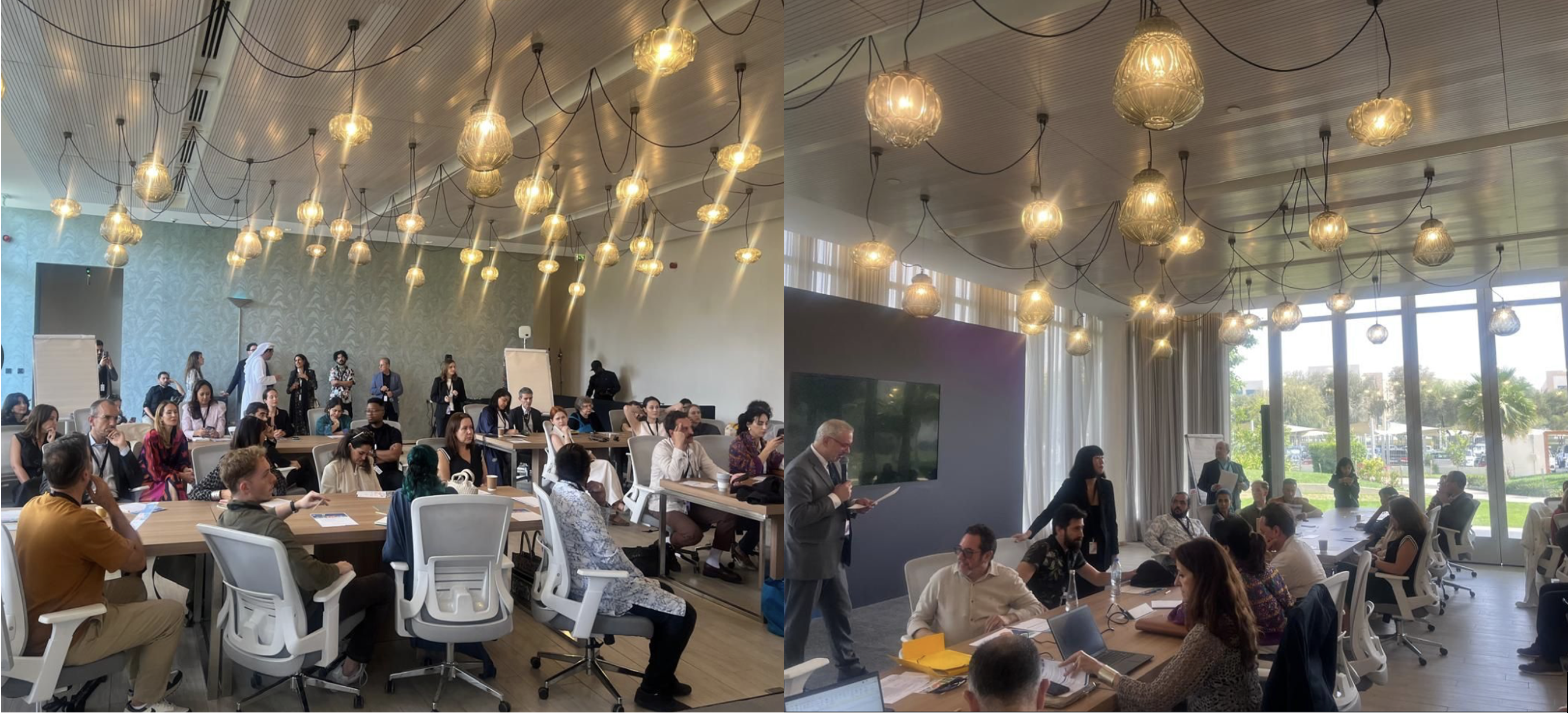Rethinking Cultural Indicators as a Lever for Sustainable Development: Insights from the Culture Summit Abu Dhabi 2025
Published in Social Sciences, Sustainability, and Statistics

In April 2025, UNESCO and its Institute for Statistics, in collaboration with the Department of Culture and Tourism – Abu Dhabi, held a workshop on "Rethinking Cultural Measurement" as part of the Culture Summit Abu Dhabi entitled "For Humanity and Beyond".
The "Rethinking Cultural Measurement" workshop addressed the challenges facing cultural measurement and explored ways to improve data collection in the culture sector. Considering the global momentum to establish culture as a stand-alone goal in the post-2030 Agenda for Sustainable Development, the development of the new 2025 UNESCO Framework for Culture Statistics (FCS), and the growing importance of data and indicators, there exists a pressing need to rethink cultural data in response to the evolving demands of measurement and the corresponding statistical landscape.
Photos above: “Rethinking Cultural Measurement” workshop, organized by DCT Abu Dhabi and UNESCO as part of the Culture Summit Abu Dhabi 2025.

Photos above: “Rethinking Cultural Measurement” workshop, organized by DCT Abu Dhabi and UNESCO as part of the Culture Summit Abu Dhabi 2025.
Over the course of four sessions, the workshop identified challenges and proposed solutions related to the measurement of culture in each of the following themes:
- National statistical capacity building
- Data collection frameworks and methodologies
- Impact of digitization
- Development of cultural indicators
The summary below brings together the results of the working group who focused on the "Development of cultural indicators" theme. Following a set of steps to reflect on what matters most in cultural measurement, participants in this group were invited to imagine and design their own cultural indicator that defined the future of the culture sector. The results presented by the working group, visualized in the word cloud below, highlighted three forward-looking approaches to developing cultural indicators:
- Nurturing the data ecosystem as a solid framework for indicator building.
- Recognizing cultural innovation and the spill-over effects of culture.
- Identifying how communities actively shape culture, sense of belonging, values, and social cohesion.

-
Nurturing the data ecosystem as a solid framework for indicator building
How we define, collect, and use data about culture
Key challenges:
When framing the cultural data ecosystem, most participants identified key challenges related to the collection and analysis of cultural data. These challenges consisted of lack of standardization and unified methodology across various stakeholders that hinder comparability and coordination among different regions and countries. This produces fragmented and dispersed data, difficult to manage, analyze, and effectively integrate across locations and databases. Data fragmentation can also lead to lack of transparency, difficult access, and misclassification issues. Over-reliance on traditional frameworks and data collection methods such as surveys, registries and behavioral observation causes inadequate tracking of cultural participation, while hindering innovation and compromising the impact of cultural policies.
Participants also discussed underinvestment in cultural statistics and research that limits the access to comprehensive datasets and hinders the possibility to conduct in-depth and longitudinal analyses. Misclassification of cultural data and the use of inconsistent key performance indicators (KPIs) further undermine data quality, making it difficult to track trends, measure outcomes, or identify the areas where financial support is needed.
Action areas:
The discussion moved towards possibilities to address these shortcomings to strengthen cultural data systems. Several were the suggested action areas. First, the adoption of standardized definitions and categorization of cultural sectors and practices is seen as essential to ensure consistency and comparability across datasets and regions. Second, the combination of traditional surveys and digital platforms can be used to capture the full scope of cultural activities. Third, promoting transparency and fostering cooperation across key stakeholders (e.g., government agencies, cultural practitioners, private entities) would enhance data reliability and accessibility. Finally, it seems imperative to address data gaps, particularly in grey areas, such as informal or unlicensed artistic work, often overlooked despite their significant contribution to the cultural ecosystem.
Suggested sample indicators:
After discussion, the working group developed the following indicators:
- Number of national culture statistics datasets updated annually
- Percentage of cultural institutions using standardized data tools
- Number of data-sharing agreements among relevant entities
- Volume of investment in culture data infrastructure
2. Recognizing cultural innovation and the spill-over effects of culture
How culture inspires and transforms other fields
Key challenges:
The working group agreed that an inclusive knowledge-based economy is based on the recognition and support of cultural innovation. Cultural innovation includes not only artistic expressions and digital creativity, where CCIs play a role of catalysts in driving innovation across sectors such as health, education, and urban planning. The inclusion of these non-culture sectors often introduces fresh perspectives and ground-breaking methods to cultural measurements. To fully understand and harness this impact, it is then essential to develop tools that can capture the non-linear, long-term, and often indirect effects of cultural innovation. The group also mentioned the importance of cultural indicators in measuring the effects of soft power, as most existing indicators fail to consider its multidimensional nature. Measuring these spillover effects requires an expanded framework of shared indicators that go beyond traditional statistical frameworks and that can capture these effects across multiple sectors over time.
Action areas:
Culture serves as a powerful cross-sectoral driver of innovation encompassing technology, sustainability, education, health, urban planning, sustainability, and governance. Despite this broad impact, effects of intangible innovation (and relevant IP) can be difficult to measure because of its elusive and heterogenous nature. Promotion of cross-sector collaboration and the development of comprehensive metrics tools can ensure a more holistic approach to recognize interactions and mechanisms that drive cultural innovation.
Suggested sample indicators:
After discussion, the working group developed the following indicators:
- Number of registered culture-inspired innovations or patents
- Number of disputes and litigations in the specialized IP courts
- Rate of adoption of culture-linked solutions in health or education
- Degree of adoption of cultural innovation by stakeholders
- Innovation increase rate
- Volume of private sector investment in culture
3. Identifying how communities actively shape culture, sense of belonging, values, and social cohesion.
How people engage with, belong to, and shape culture
- Key challenges:
Measuring how people engage with culture through relevant indicators - both single and composite - was an important element of the working group’s discussion. This approach goes beyond counting attendance at events, educational programs, libraries, or festivals. Instead, it captures the culture’s symbolic and emotional dimensions, such as inspiration, values, tolerance, and curiosity. These dimensions, which are often difficult to operationalize and quantify, play a vital role in fostering belonging, cultural awareness, and intergenerational knowledge transmission. Equally important is capturing the value of grassroots and informal cultural expressions, which often serve as powerful and sustainable tools for connecting communities.
Action areas:
Measuring cultural participation across ages, sectors, and demographics is essential for building resilient and cohesive societies. Specific sets of indicators need to be supported to further valorize initiatives that facilitate mutual understanding and social cohesion, including the transmission of intangible cultural heritage and identity elements across generations. Moreover, adopting metrics for the exchange and global circulation of cultural expressions - through media, art, semantics, and heritage practices - would allow for the recognition and valorization of those cultural assets that are often regarded as 'intangible' or 'symbolic'.
Suggested sample indicators:
After discussion, the working group developed the following indicators:
- Percentage of youth attending cultural events quarterly (outside school trips)
- Number of joint cultural initiatives across different territorial entities
- Changes in public sentiment (polls on belonging, recognition of symbols)
- Correlation between cultural engagement and preventive health metrics
In Conclusion
The session on "Development of cultural indicators" offered participants the opportunity to rethink cultural indicators beyond current limitations of data systems or policies. When asked what they would measure without constraints and through any kind of data or tools, the working group suggested indicators that would reimagine the meaning and impact of culture. In a way, the workshop provided a space to reconsider existing approaches to cultural measurements, opening possibilities to transform data collection, influence other fields, and shape culture and communities worldwide.
Special thanks to Ernesto Ottone Ramírez, Matilda Machimura, José Pessoa, Sara García de Ugarte, Pablo Guayasamín Madrinán, and Dr. Natalia Grincheva for their valuable collaboration and support throughout the workshop and beyond. A special thank you also to the workshop’s participants for their strong engagement and brilliant ideas.
References
Department of Culture and Tourism – Abu Dhabi. (2025). Culture Summit Abu Dhabi 2025: Culture for Humanity and Beyond. Retrieved May 9, 2025, from https://www.culturesummitabudhabi.com/en
Di Mauro, G., & Raevskikh, E. (2024, January 23). Measuring the impact of artistic innovation on sustainable development. Association for Cultural Economics International. Retrieved May 9, 2025, from https://culturaleconomics.org/measuring-the-impact-of-artistic-innovation-on-sustainable-development/
Raevskikh, E., Di Mauro, G., & Jaffré, M. (2024). From living heritage values to value-based policymaking: Exploring new indicators for Abu Dhabi’s sustainable development. Humanities and Social Sciences Communications, 11, Article 1311. https://doi.org/10.1057/s41599-024-03841-5
Raevskikh, E., Di Mauro, G., & Jaffré, M. (2024). From living heritage values to value-based policymaking: Exploring new indicators for Abu Dhabi’s sustainable development. Springer Research Communities Blog. https://communities.springernature.com/posts/from-living-heritage-values-to-value-based-policymaking-exploring-new-indicators-for-abu-dhabi-s-sustainable-development
Raevskikh, E., Haidar, R. O., & Alkhamis, N. (2021). Cultural indicators in Abu Dhabi: Theoretic framework and challenges for their building. Quality & Quantity, 55(6), 2065–2086. https://link.springer.com/article/10.1007/s11135-020-01090-7
UNESCO. (2025). 2025 UNESCO framework for cultural statistics. UNESCO. Retrieved May 9, 2025, from https://uis.unesco.org/en/news/CONSULTATION-REVISED-UNESCO-FRAMEWORK-CULTURE-STATISTICS
UNESCO. (2025).Towards culture as a stand-alone goal. UNESCO. Retrieved May 9, 2025, from https://www.unesco.org/en/mondiacult/themehttps://www.unesco.org/en/mondiacult/about
UNESCO, & DCT Abu Dhabi. (2022). Culture in times of COVID-19: Resilience, recovery and revival. Retrieved May 9, 2025, from https://unesdoc.unesco.org/ark:/48223/pf0000381524
World Intellectual Property Organization. (2012). The Economic Performance of Copyright-Based Industries. WIPO. Retrieved May 9, 2025, from https://www.wipo.int/en/web/copyright/economic-performance
Follow the Topic
What are SDG Topics?
An introduction to Sustainable Development Goals (SDGs) Topics and their role in highlighting sustainable development research.
Continue reading announcement





Please sign in or register for FREE
If you are a registered user on Research Communities by Springer Nature, please sign in